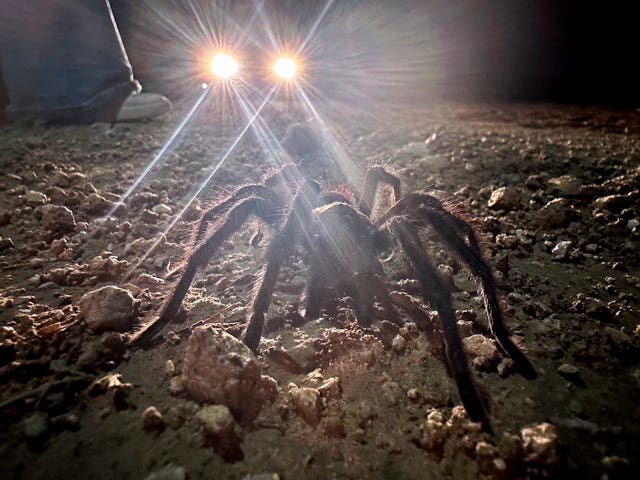Spider lovers scurry to Colorado town in search of mating tarantulas
Hundreds of enthusiasts flocked to the small farming town of La Junta, which hosts the Tarantula Festival, to watch the huge spiders emerge in droves.

Hundreds of arachnophiles flocked to a town in Colorado to spot spiders as the tarantula mating season got under way.
During the season male spiders scuttle out of their burrows in search of a mate, and scores of enthusiasts visit the small farming town of La Junta to watch them emerge in droves.
Groups piled into buses just before dusk last weekend as tarantulas began to roam the dry, rolling plains. Some used torches and car headlights to spot the arachnids once the sun set.

Back in the town, festivalgoers took part in a hairy leg contest — a woman claimed the title this year — and paraded around in vintage cars with giant spiders on the hoods.
The 1990 cult classic film Arachnophobia, which follows a small town similarly overrun with spiders, screened at a local cinema.
For residents of La Junta, tarantulas are an important part of the local ecosystem.
Among the visitors to the area was Nathan Villareal, a tarantula breeder from Santa Monica, California, who said he heard about the mating season and knew it was a spectacle he needed to witness. Mr Villareal sells tarantulas as pets and said he has been fascinated with them since childhood.
Colorado brown tarantulas are the most common in the La Junta area, and they form their burrows in the largely undisturbed prairies of the Comanche National Grassland.

In September and October, the mature males wander in search of a female’s burrow, which she typically marks with silk webbing. Peak viewing time is an hour before dusk when the heat of the day dies down.
“We saw at least a dozen tarantulas on the road, and then we went back afterwards and saw another dozen more,” Mr Villareal said.
Male tarantulas take around seven years to reach reproductive readiness, then spend the rest of their lifespan searching for a mate, said Cara Shillington, a biology professor at Eastern Michigan University who studies arachnids. They typically live for about a year after reaching sexual maturity, while females can live for 20 years or more.

The males grow to be about five inches long and develop a pair of appendages on their heads that they use to drum outside a female’s burrow. She will crawl to the surface if she is a willing mate, and the male will hook its legs onto her fangs.
Their coupling is quick, as the male tries to get away before he is eaten by the female, who tends to be slightly larger and needs extra nutrients to sustain her pregnancy.
Many children who attended the festival with their families learned that spiders are not as scary as they might seem. Roslyn Gonzales, 13, said she could not wait to go searching for spiders at sunset.

For graduate student Goran Shikak, whose arm was crawling with spider tattoos, the yearly festival represents an opportunity to celebrate tarantulas with others who share his fascination.
“They’re beautiful creatures,” said Goran, an arachnology student at the University of Colorado. “And getting to watch them do what they do … is a joy and experience that’s worth watching in the wild.”
Like many who attended the festival, Ms Shillington is passionate about teaching people not to fear tarantulas and other spiders.
Tarantulas found in North America tend to be docile creatures, she explained. Their venom is not considered dangerous to humans but can cause pain and irritation.
“When you encounter them, they’re more afraid of you,” she said. “Tarantulas only bite out of fear. This is the only way that they have to protect themselves, and if you don’t put them in a situation where they feel like they have to bite, then there is no reason to fear them.”





